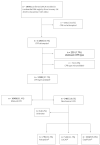Use of Mechanical Chest Compression for Resuscitation in Out-Of-Hospital Cardiac Arrest-Device Matters: A Propensity-Score-Based Match Analysis
- PMID: 37445464
- PMCID: PMC10342898
- DOI: 10.3390/jcm12134429
Use of Mechanical Chest Compression for Resuscitation in Out-Of-Hospital Cardiac Arrest-Device Matters: A Propensity-Score-Based Match Analysis
Abstract
Background: Devices for mechanical cardiopulmonary resuscitation (CPR) are recommended when high quality CPR cannot be provided. Different devices are available, but the literature is poor in direct comparison studies. Our aim was to assess whether the type of mechanical chest compressor could affect the probability of return of spontaneous circulation (ROSC) and 30-day survival in Out-of-Hospital Cardiac Arrest (OHCA) patients as compared to manual standard CPR.
Methods: We considered all OHCAs that occurred from 1 January 2015 to 31 December 2022 in seven provinces of the Lombardy region equipped with three different types of mechanical compressor: Autopulse®(ZOLL Medical, MA), LUCAS® (Stryker, MI), and Easy Pulse® (Schiller, Switzerland).
Results: Two groups, 2146 patients each (manual and mechanical CPR), were identified by propensity-score-based random matching. The rates of ROSC (15% vs. 23%, p < 0.001) and 30-day survival (6% vs. 14%, p < 0.001) were lower in the mechanical CPR group. After correction for confounders, Autopulse® [OR 2.1, 95%CI (1.6-2.8), p < 0.001] and LUCAS® [OR 2.5, 95%CI (1.7-3.6), p < 0.001] significantly increased the probability of ROSC, and Autopulse® significantly increased the probability of 30-day survival compared to manual CPR [HR 0.9, 95%CI (0.8-0.9), p = 0.005].
Conclusion: Mechanical chest compressors could increase the rate of ROSC, especially in case of prolonged resuscitation. The devices were dissimilar, and their different performances could significantly influence patient outcomes. The load-distributing-band device was the only mechanical chest able to favorably affect 30-day survival.
Keywords: cardiac arrest; cardiopulmonary resuscitation; mechanical chest compression; resuscitation; survival.
Conflict of interest statement
The authors declare no conflict of interest.
Figures



References
-
- Nishiyama C., Kiguchi T., Okubo M., Alihodžić H., Al-Araji R., Baldi E., Beganton F., Booth S., Bray J., Christensen E., et al. Three-year trends in out-of-hospital cardiac arrest across the world: Second report from the International Liaison Committee on Resuscitation (ILCOR) Resuscitation. 2023;186:109757. doi: 10.1016/j.resuscitation.2023.109757. - DOI - PubMed
-
- Czapla M., Zielińska M., Kubica-Cielińska A., Diakowska D., Quinn T., Karniej P. Factors associated with return of spontaneous circulation after out-of-hospital cardiac arrest in Poland: A one-year retrospective study. BMC Cardiovasc. Disord. 2020;20:288. doi: 10.1186/s12872-020-01571-5. - DOI - PMC - PubMed
-
- Cummins R.O., Ornato J.P., Thies W.H., Pepe P.E. Improving Survival From Sudden Cardiac Arrest: The “Chain of Survival” Concept. A statement for health professionals from the Advanced Cardiac Life Support Subcommittee and the Emergency Cardiac Care Committee, American Heart Association. Circulation. 1991;83:1832–1847. doi: 10.1161/01.CIR.83.5.1832. - DOI - PubMed
LinkOut - more resources
Full Text Sources

